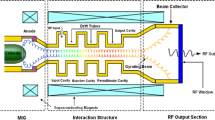We present the results of studying the passband properties of gyroklystrons theoretically and experimentally and analyze the main causes of limitations in the bandwidth of the frequencies that they amplify. It is shown that in the range of low beam currents, where the electron velocity spread is rather low, the amplification bandwidth of a two-cavity gyroklystron is close to the bandwidth of the output cavity loaded with an electron beam. In the range of high currents, the amplification bandwidth depends only weakly on the parameters of the output cavity and is determined mainly by the spread in the times of electron passing through the drift space, which is caused by the difference in their translational velocities. Good qualitative agreement of the calculated and experimental dependences indicates that the proposed method can be applied to the calculation and interpretation of frequency characteristics of gyroklystrons. The possibility to expand the passband of operating frequencies in the high-current region by decreasing the influence of the electron velocity spread on beam bunching in the three-cavity gyroklystron operating in the maximum acceleration regime is demonstrated experimentally. Theoretically, the developed method for calculation of frequency characteristics can be expanded to the case of a three-cavity gyroamplifier with slight modifications.
Similar content being viewed by others
References
A. A. Tolkachev, B. A. Levitan, V. E. Myasnikov, et al., Radiolokatsiya i Svyaz’, No. 4, 3–7 (2007).
I. I. Antakov, I. G. Gachev, and E. V. Zasypkin, Radiophys. Quantum Electron., 54, No. 3, 166 (2011). https://doi.org/https://doi.org/10.1007/s11141-011-9279-3
E. V. Zasypkin, I.G.Gachev, and I. I. Antakov, Radiophys. Quantum Electron., 55, No. 5, 309–317 (2012). https://doi.org/https://doi.org/10.1007/s11141-012-9370-4
N. I. Zaitsev, Yu.M.Guznov, S. V. Kuzikov, et al., Radiophys. Quantum Electron., 56, Nos. 8–9, 492–496 (2014). https://doi.org/https://doi.org/10.1007/s11141-014-9453-5
N. I. Zaitsev, A.K.Gvozdev, S. A. Zapevalov, et al., J. Commun. Tech. Electron., 59, No. 2, 164–168 (2014). https://doi.org/https://doi.org/10.1134/S1064226913120188
E.B.Abubakirov, Yu.M.Guznov, S.V. Kuzikov, et al., IEEE Trans. Microwave Theory Techniques, 66, No. 3, 1273–1278 (2018). https://doi.org/https://doi.org/10.1109/TMTT.2017.2772917
M.V. Swati, S. C. Madan, and K. J. Pradip, IEEE Trans. Plasma Sci., 44, No. 11, 2844–2851 (2016). https://doi.org/https://doi.org/10.1109/TPS.2016.2611140
A. A. Kuraev, Theory and Opimization of Electronic Microwave Devices [in Russian], Nauka i Tekhnika, Minsk (1979).
M. A. Moiseev, Radiophys. Quantum Electron., 20, No. 8, 846–849 (1977). https://doi.org/https://doi.org/10.1007/BF01038795
I. I. Antakov, V. A. Gintsburg, E. V. Zasypkin, and E. V. Sokolov, Radiophys. Quantum Electron., 18, No. 8, 884–887 (1975). https://doi.org/https://doi.org/10.1007/BF01036656
V. N. Manuilov and S. A. Polushkina, Radiophys. Quantum Electron., 52, No. 10, 714–721 (2009). https://doi.org/https://doi.org/10.1007/s11141-010-9179-y
E. V. Zasypkin and M.A.Moiseev, Radiophys. Quantum Electron., 37, No. 10, 853–862 (1994). https://doi.org/https://doi.org/10.1007/BF01038059
M. I. Petelin and V.K.Yulpatov, in: Lectures on Microwave Electronics. Book 4. 3rd Engineers’ School [in Russian], Saratov State Univ., Saratov (1974), p. 95–178.
A. N. Kuftin, V.K. Lygin, V.N.Manuilov, et al., Int. J. Infrared MM Waves, 20, No. 3, 361–382 (1999). https://doi.org/https://doi.org/10.1023/A:1021757213511
A. V. Klimov and V.N.Manuilov, Usp. Prikl. Fiz., 7, No. 1, 63–69 (2019).
E. V. Zasypkin, M.A.Moiseev, E.V. Sokolov, and V.K.Yulpatov, Int. J. Electron., 78, No. 2, 423–433 (1995). https://doi.org/https://doi.org/10.1080/00207219508926174
Author information
Authors and Affiliations
Corresponding author
Additional information
Translated from Izvestiya Vysshikh Uchebnykh Zavedenii, Radiofizika, Vol. 63, Nos. 5–6, pp. 446–456, March 2020.
Rights and permissions
About this article
Cite this article
Zasypkin, E.V. On the Influence of the Electron Velocity Spread on the Passband Properties of Gyroklystrons. Radiophys Quantum El 63, 403–412 (2020). https://doi.org/10.1007/s11141-021-10065-z
Received:
Accepted:
Published:
Issue Date:
DOI: https://doi.org/10.1007/s11141-021-10065-z



